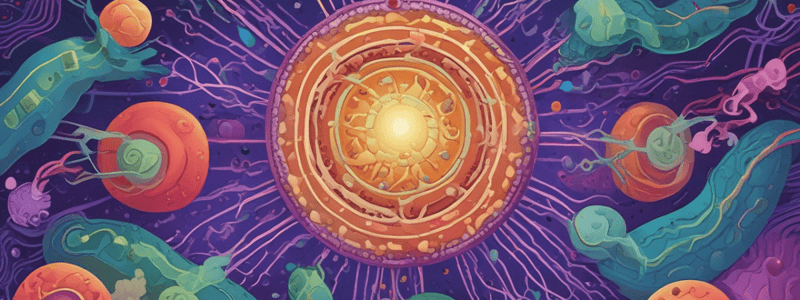Podcast
Questions and Answers
What term is defined as the time that must elapse between the last administration of a veterinary medicine and the slaughter or production of food from that animal?
What term is defined as the time that must elapse between the last administration of a veterinary medicine and the slaughter or production of food from that animal?
- Antimicrobial spectrum
- Mutation transfer
- Withdrawal period (correct)
- Metabolite concentration
Which type of resistance is acquired by bacteria through processes like conjugation, transduction, and transformation?
Which type of resistance is acquired by bacteria through processes like conjugation, transduction, and transformation?
- Acquired resistance (correct)
- Preexisting resistance
- Innate resistance
- Primary resistance
What is the main mechanism behind innate resistance in bacteria?
What is the main mechanism behind innate resistance in bacteria?
- Gene mutation
- Horizontal gene transfer
- Genomic property (correct)
- Single-cell resistance
What does AMR stand for in the context of drug therapy and antibiotic use?
What does AMR stand for in the context of drug therapy and antibiotic use?
Which process involves bacteria passing acquired resistance to other bacteria?
Which process involves bacteria passing acquired resistance to other bacteria?
What can lead to an increase in resistant bacteria even during treatment with antimicrobials?
What can lead to an increase in resistant bacteria even during treatment with antimicrobials?
How do antimicrobials contribute to the spread of antibiotic resistance genes (ARGs) between bacteria?
How do antimicrobials contribute to the spread of antibiotic resistance genes (ARGs) between bacteria?
What is one of the consequences of stress-induced activation of mutagenesis response in bacteria?
What is one of the consequences of stress-induced activation of mutagenesis response in bacteria?
Under supra-MIC conditions, what happens to the mutation rates as compared to original conditions?
Under supra-MIC conditions, what happens to the mutation rates as compared to original conditions?
Why do various components of the environment act as a depository for the accumulation, formation, and spread of antibiotic resistance?
Why do various components of the environment act as a depository for the accumulation, formation, and spread of antibiotic resistance?
How do antibacterials interfere with bacterial cell life or growth?
How do antibacterials interfere with bacterial cell life or growth?
Which of the following is NOT a common administration route for drug therapy?
Which of the following is NOT a common administration route for drug therapy?
What is the primary purpose of antimicrobial agents?
What is the primary purpose of antimicrobial agents?
Which principle is referred to as ADME in drug therapy?
Which principle is referred to as ADME in drug therapy?
What is a key property of a drug related to maintaining concentrations at the site of action without causing toxicity?
What is a key property of a drug related to maintaining concentrations at the site of action without causing toxicity?
What is the primary consideration to prevent the emergence of antimicrobial resistance?
What is the primary consideration to prevent the emergence of antimicrobial resistance?
Which factor is crucial for the effectiveness of drug therapy in killing pathogens?
Which factor is crucial for the effectiveness of drug therapy in killing pathogens?
In drug therapy, which killing pattern is characterized by antimicrobial effect increasing with a greater drug concentration?
In drug therapy, which killing pattern is characterized by antimicrobial effect increasing with a greater drug concentration?
What does the hybrid pattern in drug therapy refer to?
What does the hybrid pattern in drug therapy refer to?
Which factor determines the effectiveness of antibiotics in killing pathogens according to the text?
Which factor determines the effectiveness of antibiotics in killing pathogens according to the text?
What does the area under the serum concentration curve (AUC) after a dose of antibiotic measure?
What does the area under the serum concentration curve (AUC) after a dose of antibiotic measure?
How are breakpoints for defining bacterial susceptibility set?
How are breakpoints for defining bacterial susceptibility set?
What does the term 'Intermediate' mean when categorizing bacterial strains?
What does the term 'Intermediate' mean when categorizing bacterial strains?
What is the Acceptable Daily Intake (ADI) defined as?
What is the Acceptable Daily Intake (ADI) defined as?
What is the purpose of a withdrawal period in food-producing animals?
What is the purpose of a withdrawal period in food-producing animals?
What does PHARMACOKINETICS (PK) primarily study?
What does PHARMACOKINETICS (PK) primarily study?
Which of the following is NOT a component of the ADME principle in pharmacokinetics?
Which of the following is NOT a component of the ADME principle in pharmacokinetics?
What is the minimum inhibitory concentration (MIC) defined as?
What is the minimum inhibitory concentration (MIC) defined as?
Potency of a drug is determined by:
Potency of a drug is determined by:
In what way do PK/PD relationships influence drug therapy?
In what way do PK/PD relationships influence drug therapy?
Which type of antibiotic requires active growth of bacteria to be effective?
Which type of antibiotic requires active growth of bacteria to be effective?
What does the Minimum Bactericidal Concentration (MBC) measure in relation to antibiotics?
What does the Minimum Bactericidal Concentration (MBC) measure in relation to antibiotics?
Which type of antimicrobial acts against a limited group of bacteria?
Which type of antimicrobial acts against a limited group of bacteria?
What is the main difference between bacteriostatic and bactericidal antibiotics?
What is the main difference between bacteriostatic and bactericidal antibiotics?
What do broad-spectrum antimicrobials act against?
What do broad-spectrum antimicrobials act against?
In the disk diffusion test, what do the diameters of inhibition zones indicate?
In the disk diffusion test, what do the diameters of inhibition zones indicate?
What does the term 'bacteriostatic' mean in relation to antibiotics?
What does the term 'bacteriostatic' mean in relation to antibiotics?
'Spectrum of activity' in drug therapy refers to the antibiotics' ability to act against:
'Spectrum of activity' in drug therapy refers to the antibiotics' ability to act against:
'Minimum Bactericidal Concentration' (MBC) is defined as the lowest concentration at which:
'Minimum Bactericidal Concentration' (MBC) is defined as the lowest concentration at which:
'BacteriCIDAL agents' differ from 'BacterioSTATIC agents' in that they:
'BacteriCIDAL agents' differ from 'BacterioSTATIC agents' in that they:
Flashcards are hidden until you start studying
Study Notes
Drug Therapy Principles
- Definition of Drug Therapy: Any medical treatment that utilizes one or more drugs to provide symptomatic relief, treat the underlying condition, or act as a prevention for diseases.
Factors Affecting Drug Choice
- Factors to Consider: Selectivity, Concentrations, Time
- Selectivity: Target vs non-desired targets
- Concentrations: Sufficient at the site of action vs toxicity
- Time: Maintenance vs depletion
Antibiotics/Antimicrobials
- Definition: Any substance of natural, semisynthetic, or synthetic origin that either kills microbes or prevents their multiplication, reducing their pathogenic effect.
- Mechanisms of Action:
- Destroying bacterial cell membranes
- Preventing bacterial cell wall synthesis
- Disrupting bacterial metabolic pathways
- Interfering with bacterial DNA synthesis
Administration Routes
- Systemic Routes: Enteral, Parenteral, Inhalation
- Local Routes: Topical, Transdermal, Intramammary, Rectal, Intramuscular, Subcutaneous
Antimicrobial Resistance (AMR)
- Definition: The ability of microorganisms to resist the effects of antimicrobial agents.
- Mechanisms of Resistance:
- Innate (natural) resistance
- Acquired resistance (mutation or horizontal gene transfer)
- Factors Contributing to AMR:
- Antibiotic Stress Response
- Mutation rates increased under supra-MIC conditions
- Horizontal gene transfer
- Environmental reservoirs of antibiotic resistance genes
Pharmacokinetics (PK) and Pharmacodynamics (PD)
- PK: Study of what the body does to the drug (absorption, distribution, metabolism, and excretion)
- PD: Study of what the drug does to the body and the target
- PK/PD together: Exposure/response relationship
In Vitro Evidence
- Minimum Inhibitory Concentration (MIC): Lowest concentration of antibiotic that completely inhibits growth of the specific organism being tested
- Minimum Bactericidal Concentration (MBC): Lowest concentration of antibiotic that kills bacteria
- Disk Diffusion Test: Reference susceptibility test evaluating the diameters of inhibition zones around antibiotic-containing disks
Spectrum of Activity
- Narrow-Spectrum Antimicrobials: Act against a limited group of bacteria
- Broad-Spectrum Antimicrobials: Act against a large group of bacteria
Studying That Suits You
Use AI to generate personalized quizzes and flashcards to suit your learning preferences.




